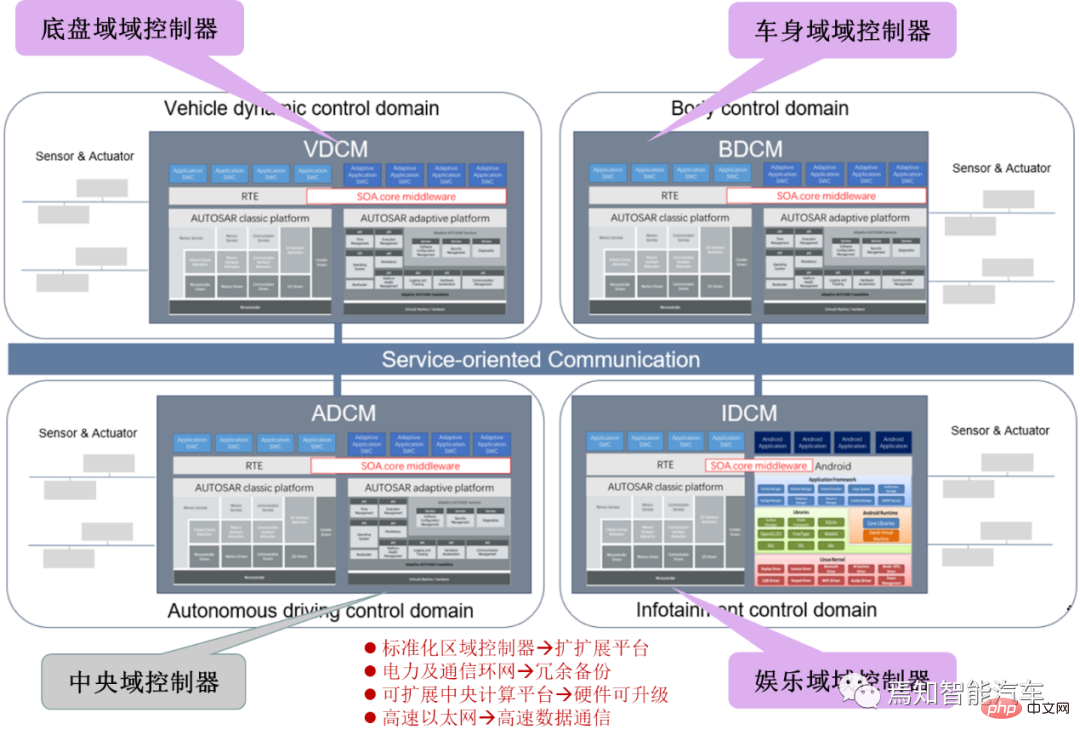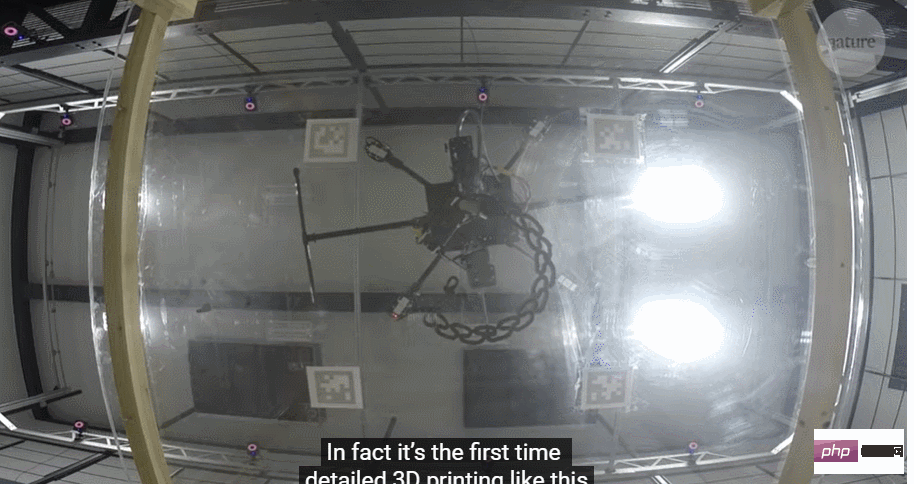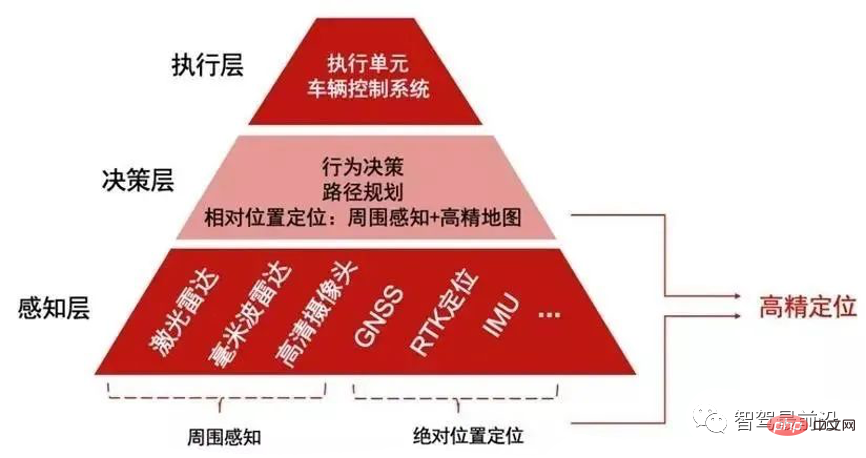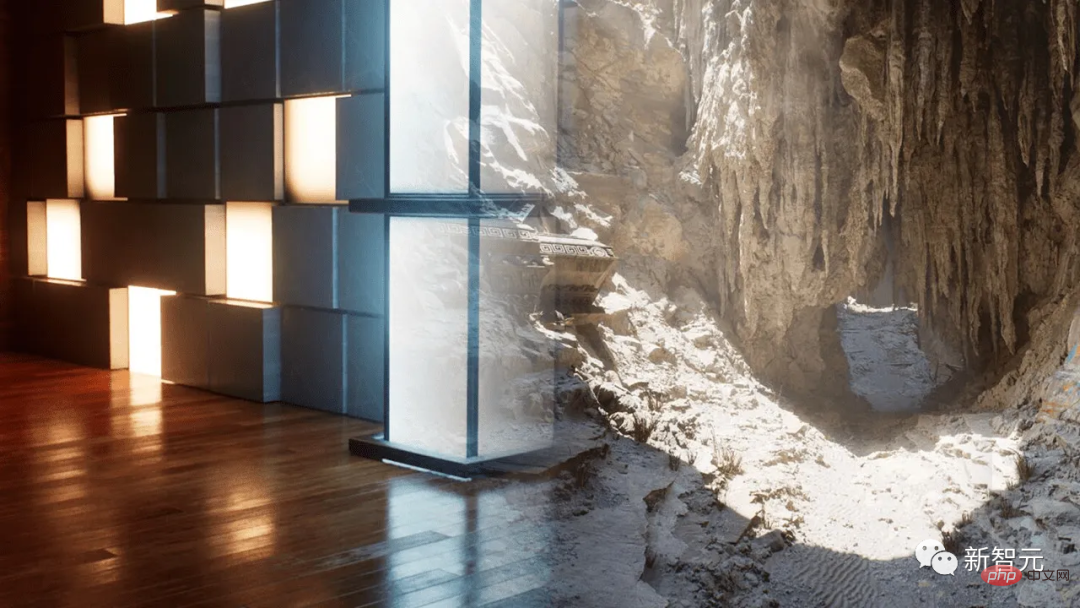 Technology peripherals
Technology peripherals AI
AI Exploring future autonomous driving technology: 4D millimeter wave radar
Exploring future autonomous driving technology: 4D millimeter wave radarThe current realization of self-driving car perception is inseparable from sensing equipment such as lidar, on-board cameras, and millimeter-wave radar installed on the vehicle. By collecting data on the traffic environment around the vehicle, self-driving cars can surpass or even surpass humans. eyes to perceive the surrounding world and provide more accurate and rich environmental information for the decision-making and planning module, so that self-driving cars can drive safely.

The stacking of sensor hardware allows self-driving cars to drive more safely on the road, but on the other hand, a single hardware device cannot obtain all required data. , and in many extreme environments, hardware equipment will also have problems. For example, in extreme weather such as heavy fog and heavy rain, the measured data of lidar will have large deviations; millimeter-wave radar does not have the ability to measure altitude, and it is difficult to judge the stationary position ahead. Whether the object is on the ground or in the air; on-board cameras can only capture 2D plane images. Even with the assistance of deep learning, they still cannot accurately measure the distance between surrounding objects and self-driving cars. Therefore, self-driving cars require different hardware equipment. Working simultaneously, autonomous vehicles can achieve perception accuracy and capabilities that are no less than those of humans under any circumstances. The emergence of 4D millimeter wave radar will bring revolutionary changes to autonomous driving.
What is 4D millimeter wave radar
In autonomous driving perception, millimeter wave radar, as one of the most important sensors in autonomous driving, is a crucial one. ring. However, because it does not have the ability to measure height, it is difficult to determine whether the stationary object ahead is on the ground or in the air. When encountering ground or air objects such as manhole covers, speed bumps, overpasses, traffic signs, etc., it is impossible to accurately measure the height data of the object. . The emergence of 4D millimeter wave radar will make up for this problem. 4D millimeter wave radar is also called imaging radar. Based on the original distance, speed, and direction data, it adds a high degree of analysis of the target, and the fourth Dimensions are integrated into traditional millimeter wave radar to better understand and map the environment, making the measured traffic data more accurate.

As early as 2020, Tesla announced that it would add a 4D sensor technology to Tesla cars. Through 4D sensor technology, existing work The range is tripled for more traffic information. 4D millimeter wave radar can effectively analyze the contours, behaviors and categories of measured targets. It can adapt to more complex roads and identify more small objects, blocked objects and monitoring of stationary or horizontal objects, so that it can accurately understand the needs of vehicles. Under what circumstances should you brake? Compared with 3D millimeter wave radar, which can only measure three data: azimuth angle, elevation angle and speed, 4D millimeter wave radar can obtain more data, thus providing more reliable information for decision-making and planning.
Solution of 4D millimeter wave radar
4D millimeter wave radar was first proposed by an Israeli company in 2019. In early 2020, Waymo announced its fifth-generation autonomous driving 4D millimeter wave radar is launched in the perception suite. In the same year, Continental launched the first 4D millimeter wave radar mass production solution and stated that BMW would be the first car company to implement it. At 2021CES, 4D millimeter wave radar is also gaining momentum. Many manufacturers have unveiled their products. Texas Instruments, Mobileye and other companies have successively launched or updated 4D millimeter wave radar solutions.
Last year, Aptiv unveiled its next-generation L1~L3 autonomous driving platform, claiming that its sensor suite included 4D millimeter wave radar; ZF said it had obtained a production order for 4D millimeter wave radar from SAIC Group , will be officially supplied in 2022; Bosch launches the 5th generation radar extreme version, namely 4D millimeter wave radar, for the first time in the Chinese market.
4D millimeter wave radar, like traditional radar, will not experience great deviations when working under extreme weather conditions, and after increasing the elevation angle, it can form point cloud images, which means that 4D millimeter wave radar The radar can not only detect the distance, relative speed and azimuth of the object, but also detect the vertical height of the object in front as well as stationary and laterally moving objects in front, which will make up for the shortcomings of traditional radar in detecting static targets. At present, there are two main technical solutions for 4D millimeter wave radar:
- One is for 4D millimeter wave radar companies to independently develop multi-channel array radio frequency chipsets, radar processor chips and post-processing software algorithms based on artificial intelligence.
- The other is a solution based on traditional radar chip suppliers, which uses multi-chip extreme connection or software algorithms to achieve dense point cloud output and recognition.
The main feature of 4D millimeter wave radar is that the angular resolution is very high. The angular resolution of the front 4D millimeter wave radar can reach 1 degree in azimuth and 2 degrees in elevation. , when a self-driving car equipped with 4D millimeter wave radar detects road information, it can directly detect the outline of objects around the vehicle. For example, when road information is relatively rich, such as when pedestrians and vehicles are mixed together, 4D millimeter wave radar can directly identify pedestrians and vehicles, and can determine the movement of the corresponding objects (whether they are moving and the direction of movement).
4D millimeter wave radar can also detect geometric shapes, such as the length and width of tunnels in tunnel scenes. The emergence of 4D millimeter wave radar has made up for the performance shortcomings of traditional millimeter wave radar in a targeted manner. It not only increases the dimension of 3D, but also brings about comprehensive upgrades in detection accuracy, sensitivity, resolution and performance, giving autonomous driving more capabilities. High safety is expected to make millimeter wave radar one of the core sensors in autonomous driving systems.
The future development trend of 4D millimeter wave radar
According to analysis by industry insiders, the large-scale implementation of 4D millimeter wave radar is coming soon. In terms of marketization, the current technology is becoming mature, and there are many innovative algorithms in the process of productization. Many car manufacturers already have requirements for equipping new vehicles. Among them, automatic parking and L3 and above level autonomous driving require 4D imaging. In fact, since last year, many 4D millimeter wave radar products have been installed in vehicles for road testing. and prepare for mass production.

For example, NXP announced that the industry’s first dedicated 16nm millimeter wave radar processor S32R45 will be used for customer mass production for the first time starting in the first half of the year. Mobileye, a subsidiary of Intel, is also actively promoting the development and application of 4D millimeter wave radar. Mobileye CEO Amnon Shashua emphasized the application scenarios of 4D imaging millimeter wave radar in automobiles in this year's CES speech.
He said: "By 2025, except for the front of the car, we only want millimeter-wave radar, not lidar." In Mobileye's plan, millimeter-wave radar-based radar will be launched by 2025 /Lidar's consumer-grade autonomous vehicle solution, the car is equipped with a radar-LiDAR subsystem, and the vehicle only needs to be equipped with a forward-facing lidar and a 360-degree fully-covered millimeter-wave radar to achieve autonomous driving tasks.
Autonomous driving technology cannot rely on a single sensor to dominate the world and become an industry consensus. According to the current market understanding of autonomous driving, there is no one-size-fits-all sensor, because the market has many segments and different levels of autonomous driving. In the end, it is very likely that cameras and radars will coexist because their advantages and disadvantages are very complementary. What is special is lidar. The author believes that there is a great possibility that 4D millimeter wave radar solutions can reduce or replace the use of lidar. 4D millimeter wave radar is still in the early stages of development, but the author believes that its performance will be greatly improved in the future, and under ideal circumstances, it can eventually replace lidar. ”
The above is the detailed content of Exploring future autonomous driving technology: 4D millimeter wave radar. For more information, please follow other related articles on the PHP Chinese website!
 SOA中的软件架构设计及软硬件解耦方法论Apr 08, 2023 pm 11:21 PM
SOA中的软件架构设计及软硬件解耦方法论Apr 08, 2023 pm 11:21 PM对于下一代集中式电子电器架构而言,采用central+zonal 中央计算单元与区域控制器布局已经成为各主机厂或者tier1玩家的必争选项,关于中央计算单元的架构方式,有三种方式:分离SOC、硬件隔离、软件虚拟化。集中式中央计算单元将整合自动驾驶,智能座舱和车辆控制三大域的核心业务功能,标准化的区域控制器主要有三个职责:电力分配、数据服务、区域网关。因此,中央计算单元将会集成一个高吞吐量的以太网交换机。随着整车集成化的程度越来越高,越来越多ECU的功能将会慢慢的被吸收到区域控制器当中。而平台化
 新视角图像生成:讨论基于NeRF的泛化方法Apr 09, 2023 pm 05:31 PM
新视角图像生成:讨论基于NeRF的泛化方法Apr 09, 2023 pm 05:31 PM新视角图像生成(NVS)是计算机视觉的一个应用领域,在1998年SuperBowl的比赛,CMU的RI曾展示过给定多摄像头立体视觉(MVS)的NVS,当时这个技术曾转让给美国一家体育电视台,但最终没有商业化;英国BBC广播公司为此做过研发投入,但是没有真正产品化。在基于图像渲染(IBR)领域,NVS应用有一个分支,即基于深度图像的渲染(DBIR)。另外,在2010年曾很火的3D TV,也是需要从单目视频中得到双目立体,但是由于技术的不成熟,最终没有流行起来。当时基于机器学习的方法已经开始研究,比
 多无人机协同3D打印盖房子,研究登上Nature封面Apr 09, 2023 am 11:51 AM
多无人机协同3D打印盖房子,研究登上Nature封面Apr 09, 2023 am 11:51 AM我们经常可以看到蜜蜂、蚂蚁等各种动物忙碌地筑巢。经过自然选择,它们的工作效率高到叹为观止这些动物的分工合作能力已经「传给」了无人机,来自英国帝国理工学院的一项研究向我们展示了未来的方向,就像这样:无人机 3D 打灰:本周三,这一研究成果登上了《自然》封面。论文地址:https://www.nature.com/articles/s41586-022-04988-4为了展示无人机的能力,研究人员使用泡沫和一种特殊的轻质水泥材料,建造了高度从 0.18 米到 2.05 米不等的结构。与预想的原始蓝图
 如何让自动驾驶汽车“认得路”Apr 09, 2023 pm 01:41 PM
如何让自动驾驶汽车“认得路”Apr 09, 2023 pm 01:41 PM与人类行走一样,自动驾驶汽车想要完成出行过程也需要有独立思考,可以对交通环境进行判断、决策的能力。随着高级辅助驾驶系统技术的提升,驾驶员驾驶汽车的安全性不断提高,驾驶员参与驾驶决策的程度也逐渐降低,自动驾驶离我们越来越近。自动驾驶汽车又称为无人驾驶车,其本质就是高智能机器人,可以仅需要驾驶员辅助或完全不需要驾驶员操作即可完成出行行为的高智能机器人。自动驾驶主要通过感知层、决策层及执行层来实现,作为自动化载具,自动驾驶汽车可以通过加装的雷达(毫米波雷达、激光雷达)、车载摄像头、全球导航卫星系统(G
 超逼真渲染!虚幻引擎技术大牛解读全局光照系统LumenApr 08, 2023 pm 10:21 PM
超逼真渲染!虚幻引擎技术大牛解读全局光照系统LumenApr 08, 2023 pm 10:21 PM实时全局光照(Real-time GI)一直是计算机图形学的圣杯。多年来,业界也提出多种方法来解决这个问题。常用的方法包通过利用某些假设来约束问题域,比如静态几何,粗糙的场景表示或者追踪粗糙探针,以及在两者之间插值照明。在虚幻引擎中,全局光照和反射系统Lumen这一技术便是由Krzysztof Narkowicz和Daniel Wright一起创立的。目标是构建一个与前人不同的方案,能够实现统一照明,以及类似烘烤一样的照明质量。近期,在SIGGRAPH 2022上,Krzysztof Narko
 一文聊聊智能驾驶系统与软件升级的关联设计方案Apr 11, 2023 pm 07:49 PM
一文聊聊智能驾驶系统与软件升级的关联设计方案Apr 11, 2023 pm 07:49 PM由于智能汽车集中化趋势,导致在网络连接上已经由传统的低带宽Can网络升级转换到高带宽以太网网络为主的升级过程。为了提升车辆升级能力,基于为车主提供持续且优质的体验和服务,需要在现有系统基础(由原始只对车机上传统的 ECU 进行升级,转换到实现以太网增量升级的过程)之上开发一套可兼容现有 OTA 系统的全新 OTA 服务系统,实现对整车软件、固件、服务的 OTA 升级能力,从而最终提升用户的使用体验和服务体验。软件升级触及的两大领域-FOTA/SOTA整车软件升级是通过OTA技术,是对车载娱乐、导
 internet的基本结构与技术起源于什么Dec 15, 2020 pm 04:48 PM
internet的基本结构与技术起源于什么Dec 15, 2020 pm 04:48 PMinternet的基本结构与技术起源于ARPANET。ARPANET是计算机网络技术发展中的一个里程碑,它的研究成果对促进网络技术的发展起到了重要的作用,并未internet的形成奠定了基础。arpanet(阿帕网)为美国国防部高级研究计划署开发的世界上第一个运营的封包交换网络,它是全球互联网的始祖。
 综述:自动驾驶的协同感知技术Apr 08, 2023 pm 03:01 PM
综述:自动驾驶的协同感知技术Apr 08, 2023 pm 03:01 PMarXiv综述论文“Collaborative Perception for Autonomous Driving: Current Status and Future Trend“,2022年8月23日,上海交大。感知是自主驾驶系统的关键模块之一,然而单车的有限能力造成感知性能提高的瓶颈。为了突破单个感知的限制,提出协同感知,使车辆能够共享信息,感知视线之外和视野以外的环境。本文回顾了很有前途的协同感知技术相关工作,包括基本概念、协同模式以及关键要素和应用。最后,讨论该研究领域的开放挑战和问题


Hot AI Tools

Undresser.AI Undress
AI-powered app for creating realistic nude photos

AI Clothes Remover
Online AI tool for removing clothes from photos.

Undress AI Tool
Undress images for free

Clothoff.io
AI clothes remover

AI Hentai Generator
Generate AI Hentai for free.

Hot Article

Hot Tools

SAP NetWeaver Server Adapter for Eclipse
Integrate Eclipse with SAP NetWeaver application server.

MinGW - Minimalist GNU for Windows
This project is in the process of being migrated to osdn.net/projects/mingw, you can continue to follow us there. MinGW: A native Windows port of the GNU Compiler Collection (GCC), freely distributable import libraries and header files for building native Windows applications; includes extensions to the MSVC runtime to support C99 functionality. All MinGW software can run on 64-bit Windows platforms.

VSCode Windows 64-bit Download
A free and powerful IDE editor launched by Microsoft

MantisBT
Mantis is an easy-to-deploy web-based defect tracking tool designed to aid in product defect tracking. It requires PHP, MySQL and a web server. Check out our demo and hosting services.

mPDF
mPDF is a PHP library that can generate PDF files from UTF-8 encoded HTML. The original author, Ian Back, wrote mPDF to output PDF files "on the fly" from his website and handle different languages. It is slower than original scripts like HTML2FPDF and produces larger files when using Unicode fonts, but supports CSS styles etc. and has a lot of enhancements. Supports almost all languages, including RTL (Arabic and Hebrew) and CJK (Chinese, Japanese and Korean). Supports nested block-level elements (such as P, DIV),






